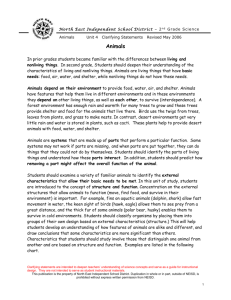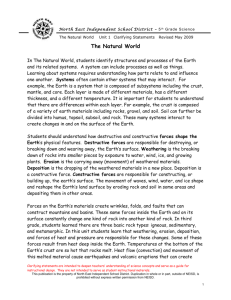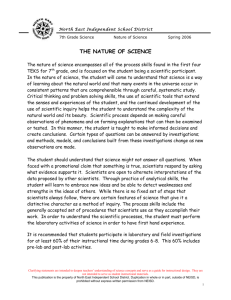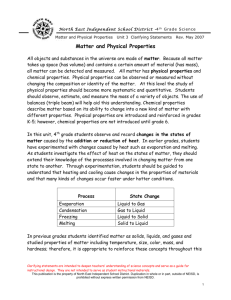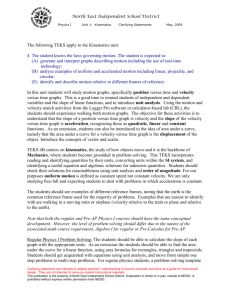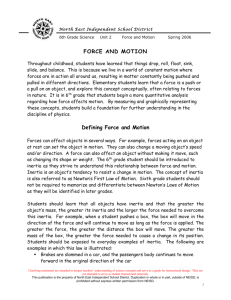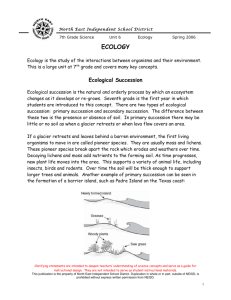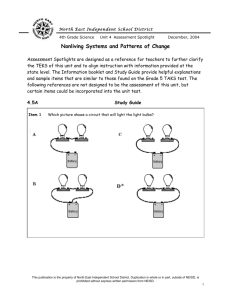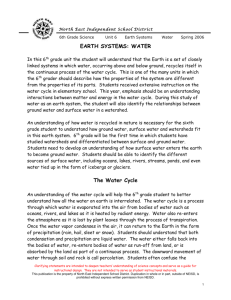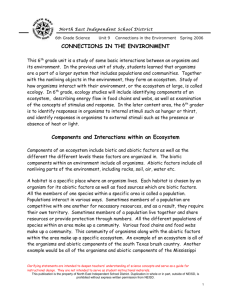Evolution and Taxonomy
advertisement
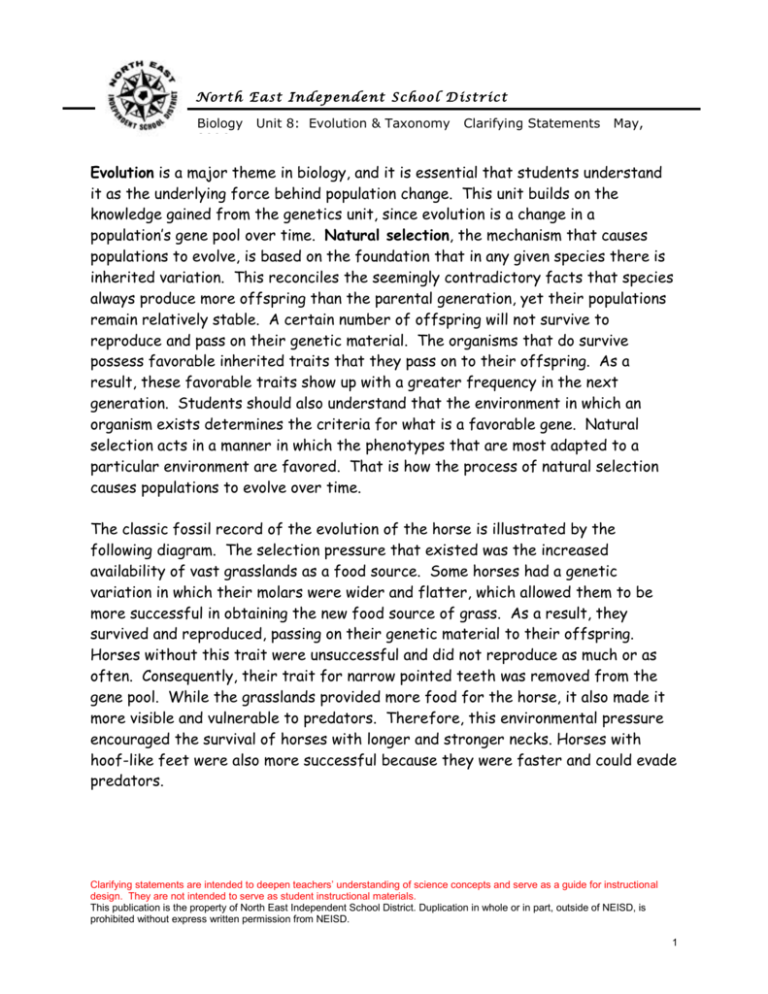
N o r t h E a st I n d ep en d e nt S c h o o l D i st ric t Biology 2006 Unit 8: Evolution & Taxonomy Clarifying Statements May, Evolution is a major theme in biology, and it is essential that students understand it as the underlying force behind population change. This unit builds on the knowledge gained from the genetics unit, since evolution is a change in a population’s gene pool over time. Natural selection, the mechanism that causes populations to evolve, is based on the foundation that in any given species there is inherited variation. This reconciles the seemingly contradictory facts that species always produce more offspring than the parental generation, yet their populations remain relatively stable. A certain number of offspring will not survive to reproduce and pass on their genetic material. The organisms that do survive possess favorable inherited traits that they pass on to their offspring. As a result, these favorable traits show up with a greater frequency in the next generation. Students should also understand that the environment in which an organism exists determines the criteria for what is a favorable gene. Natural selection acts in a manner in which the phenotypes that are most adapted to a particular environment are favored. That is how the process of natural selection causes populations to evolve over time. The classic fossil record of the evolution of the horse is illustrated by the following diagram. The selection pressure that existed was the increased availability of vast grasslands as a food source. Some horses had a genetic variation in which their molars were wider and flatter, which allowed them to be more successful in obtaining the new food source of grass. As a result, they survived and reproduced, passing on their genetic material to their offspring. Horses without this trait were unsuccessful and did not reproduce as much or as often. Consequently, their trait for narrow pointed teeth was removed from the gene pool. While the grasslands provided more food for the horse, it also made it more visible and vulnerable to predators. Therefore, this environmental pressure encouraged the survival of horses with longer and stronger necks. Horses with hoof-like feet were also more successful because they were faster and could evade predators. Clarifying statements are intended to deepen teachers’ understanding of science concepts and serve as a guide for instructional design. They are not intended to serve as student instructional materials. This publication is the property of North East Independent School District. Duplication in whole or in part, outside of NEISD, is prohibited without express written permission from NEISD. 1 N o r t h E a st I n d ep en d e nt S c h o o l D i st ric t Biology 2006 Unit 8: Evolution & Taxonomy Clarifying Statements May, Students should understand that adaptations are the result of favorable, inherited traits. It is important that students are presented with examples of adaptations of both animals and plants. The following diagram shows examples of seed dispersal adaptations that have resulted from different environmental pressures. The pine cone breaks apart because it relies on the wind for seed dispersal. The bright color and sweet taste of berries attract animals, which eat them and ultimately expel the seeds. The cockabur uses the fur of some mammals as its method of seed dispersal. Finally, coconuts are large seeds which move from beach to beach by ocean currents. Clarifying statements are intended to deepen teachers’ understanding of science concepts and serve as a guide for instructional design. They are not intended to serve as student instructional materials. This publication is the property of North East Independent School District. Duplication in whole or in part, outside of NEISD, is prohibited without express written permission from NEISD. 2 N o r t h E a st I n d ep en d e nt S c h o o l D i st ric t Biology 2006 Unit 8: Evolution & Taxonomy Clarifying Statements May, Evolution usually occurs over large expanses of time. Sometimes the rate of evolution is gradual, while at and other times the change occurs rapidly and is followed by a period of stasis. Change may be documented by the following evidence: fossils, DNA sequences, anatomical physiological, biochemical similarities, and embryos. Students should be given opportunities to analyze laboratory evidence in order to determine the most closely related organisms in a given group. The more closely related two organisms are in terms of evolution, the more alike they will be in their DNA sequences and biochemistry. The following chart documents the amino acid composition of Cytochrome c in various animals. Using this chart, students should be able to determine which two insects are the most closely related and which two are the most distantly related. It often follows that species with similar DNA are more alike in their anatomical and physiological traits. Students should understand how environmental factors have influenced the evolution of both homologous and analogous structures. For example, the shark and dolphin both live in the ocean and have had the same selection pressures. These two creatures are not closely related, so their similar structures such as their fins are considered analogous structures rather than homologous structures. Clarifying statements are intended to deepen teachers’ understanding of science concepts and serve as a guide for instructional design. They are not intended to serve as student instructional materials. This publication is the property of North East Independent School District. Duplication in whole or in part, outside of NEISD, is prohibited without express written permission from NEISD. 3 N o r t h E a st I n d ep en d e nt S c h o o l D i st ric t Biology 2006 Unit 8: Evolution & Taxonomy Clarifying Statements May, Conversely, the hand of a chimpanzee and the wing of a bat are used for different functions and seem unrelated. Yet both of these structures have exactly the same bones and share a common origin. This is an example of homologous structures. Students should also realize that if a group of organisms changes enough, a new species may result, which produces biodiversity. On the other hand, students should know that species can also become extinct when their adaptations no longer aid in their survival. This dynamic of speciation and extinction is an on-going process in the biological world. Students must understand the definition of a species as a group of interbreeding organisms that produce viable, fertile offspring in nature. They must also realize that the term species is a man-made definition and that there are problems inherent in the definition. For example, sterile organisms such as the dandelion do not seem to fit into this definition of a species. Taxonomy, which is closely related to the principles of evolution, is another major focus of this unit. Taxonomy is the classification of living organisms based on their evolutionary history. Students should practice classifying organisms using a dichotomous key, and should be able to create their own dichotomous key. In addition, students should be able to classify an organism in the correct taxa based on its characteristics. Below are characteristics of certain animal phyla and a diagram of an organism. Students should be able to place this organism in the correct phylum. Clarifying statements are intended to deepen teachers’ understanding of science concepts and serve as a guide for instructional design. They are not intended to serve as student instructional materials. This publication is the property of North East Independent School District. Duplication in whole or in part, outside of NEISD, is prohibited without express written permission from NEISD. 4 N o r t h E a st I n d ep en d e nt S c h o o l D i st ric t Biology 2006 Unit 8: Evolution & Taxonomy Clarifying Statements May, It is essential that students understand the hierarchal nature of classification. They must be skilled in analyzing relationships among organisms. These relationships are based on evolutionary similarities and differences, and are described using taxonomic nomenclature. The students must be able to analyze a chart such as the one below and identify which organisms are the most closely related. Kingdom Phylum Class Order Family Genus Species Corn Whale Shark Humpback Whale Plantae Anthophyta Monocotyledones Commelinales Poaceae Zea Zea mays Animalia Chordata Chondrichthyes Squaliformes Rhincodontidae Rhincodon Rhinacodon typus Animalia Chordata Mammalia Cetacea Balaenopteridae Megptera Megaptera novaeangilae Spider Monkey Animalia Chordata Mammalia Primates Atelidae Ateles Ateles paniscus While different texts present different classification schemes, the TEKS are based on the six-kingdom system which includes archaebacteria, eubacteria, protists, fungi, plants and animals. Students must be familiar with the characteristics of each of these six kingdoms. It is important that students have multiple opportunities to use the characteristics of given organisms to classify them in the appropriate kingdom. (Students are not responsible to identify the characteristics of various phyla). For example, students should be able to classify the cell below into the plant kingdom. The importance of this unit should not be overlooked as 10-15% of all the TAKS questions are devoted to evolution and taxonomy. Clarifying statements are intended to deepen teachers’ understanding of science concepts and serve as a guide for instructional design. They are not intended to serve as student instructional materials. This publication is the property of North East Independent School District. Duplication in whole or in part, outside of NEISD, is prohibited without express written permission from NEISD. 5
